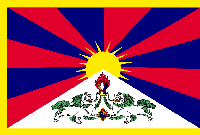|
The Tibetan National Flag is intimately connected with the authentic history and royal lineages of Tibet which are thousands of years old. Furthermore, in the Tibetan Royal year 820 or in the seventh century of the Christian era, at the time of the Tibetan religious King Song-tsan Gampo the Great, extensive land of Tibet was divided into large and small districts, an army of 2,860,000 men was chosen and stationed along the borders of Tibet, and the subjects thus lived in safety. The bravery and heroism of the Tibetan people at the time in conquering and ruling even the adjacent empire of China is well-known in world history. At that time it is recorded the regiment of Yo-ru to had a military flag with a pair of snowlions facing each other; that Ya-ru ma had a had a snow lion with a bright upper border; that of Tzang Ru-Lao had a snowlion standing upright, springing towards the sky; and the flag of U-ru to had a white flame against a red background, and so forth. In this way, the regiments of each area have had military flags with either a pair of snowlions facing each other, or a snowlion springing upwards and so forth. In the latter part of this period, during the rule of His Holiness the Great Thirteenth Dalai Lama, this eminent spiritual and temporal ruler of Tibet enacted many modifications in administrative policies in accordance with international customs. Based on the formats of previous military flags, His Holiness improved upon them and designed the present, modern national flag. With an official proclamation, He declared that this would be the uniform, standard flag to be adopted by all Tibetan military defence establishments. Since the time of that proclamation, all Tibetan regiments have likewise adopted this flag as their standard. The colour scheme of the Tibetan National Flag gives a clear indication of all aspects of Tibet in its symbolism such as the geographic features of the religious, snowy land of Tibet, the customs and traditions of Tibetan society, the political administration of the Tibetan government and so forth. History attests to the fact that Tibet is one of the most ancient nations of the world. Therefore, in all the three regions of Tibet, irrespective of caste and creed, this National Flag inherited from our ancestors is universally accepted as a common, peerless treasure and even today still continues to be highly respected and esteemed as in the past. . . . . . . . . . . . . .
EXPLANATION OF THE SYMBOLISM OF THE
1) The glorious, naturally beautiful snow mountain in the centre symbolises the land of the great nation of Tibet which is well-known as the country surrounded by snow mountains 2) The six red rays of light emanating in the sky symbolise the six original peoples of Tibet: the Se, Mu, Dong, Tong, Dru and Ra, who are Known as the six tribes 3) The alternating red colour of the peoples and the dark blue colour of the sky symbolise the unrelentless accomplishments of the virtuous conduct to guard and protect the spiritual and secular rule enacted by the two protector-deities, one red and one black, who have safeguarded from old 4) The light rays emanating extensively from the sun rising over the peak of the snow mountain symbolise all the people of Tibet's equal enjoyment of the light of freedom, spiritual and material happiness and prosperity 5) The valiant stance of a pair of fearless snowlions glowing with five prominent features on their face symbolises the complete victory over all by the deeds of the combined spiritual and secular ruling government 6) The three-coloured jewels above, beautiful and radiant with light symbolises all the Tibetan people's continually revering the three Precious Gems; the objects of refuge 7) The holding of the two-coloured jewel of bliss-swirls by the two snowlions symbolises the observance of self-morality in accordance with the exalted traditions which are represented principally by the ten divine virtuous actions and the sixteen human moral rules 8) The yellow border symbolises the flourishing and increase of the Buddha's teachings which are like pure, refined gold throughout limitless directions and time . . . . . . . . . . . . . Library of Tibetan Works and Archives, Dharamshala |
